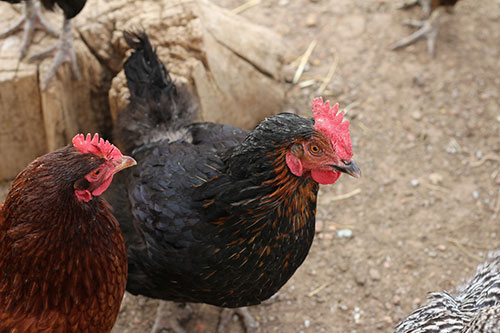
A growing number of farmers, grocery stores and restaurants are offering antibiotic-free poultry in response to consumer demand for more naturally-raised meat. Animal biosciences professor Elijah Kiarie, who holds the McIntosh Family Professorship in Poultry Nutrition, is looking at ways to raise healthier poultry by improving their diets and reducing the use of antibiotics.
Feed accounts for 60 per cent of the cost of producing meat and eggs, he says, so it’s important to maximize the chickens’ nutritional intake. “The more they digest from their feed, the less the farmer has to feed them and the more money they make,” says Kiarie. Adding enzymes and probiotics to feed can help poultry digest more of their food.
Ontario chickens are fed a diet consisting mostly of corn and soy, but about 15 per cent of the protein and four per cent of the starches go undigested. “The implication of that is very huge,” he says. Not only are these nutrients being wasted, they pollute the environment. More than 50 per cent of phosphorous in corn and soy feed is not digested and contributes to algae overgrowth in the water.
Health-conscious consumers are pushing for antibiotic-free meat, but reducing or eliminating antibiotics in feed needs to be done in a way that doesn’t put poultry health at risk.
“The real issue right now in the industry is using antibiotics to promote growth, not to treat animals,” says Kiarie. Antibiotics don’t just protect poultry from infection; they also protect them from their own gut microbes. A chicken has more gut bacteria than cells in its body, and they compete for the same nutrients. Antibiotics help control these microbes so the bird can get enough nutrients from its food and grow properly.
Without antibiotics, “what you’re going to have is a gut with blooming microbiota,” he says. “If you don’t control the microbiota, the chickens will be under constant pressure from them.”
Kiarie is looking at additives such as probiotics to manage gut microbes, especially those that cause disease. Clostridium perfringens, for example, causes necrotic enteritis, which can be fatal. A diet high in animal protein plays a role in this type of disease, so feeding less protein and adding amino acids could help, he says.
Working with Prof. John Barta in pathobiology, Kiarie is also studying feed additives to control coccidiosis, a parasitic disease that affects the intestines.
Kiarie is trying to determine what types of nutrients can strengthen the immune system of poultry to make them more resistant to disease. “Maintaining a proper immune response requires a lot of nutrients,” he says. “What we don’t know is the nutrient requirements of the immune system.” Chickens raised without antibiotics may need more nutrients to stay healthy.
Processing also affects how chickens digest their feed and absorb nutrients. Chicken feed is highly processed and finely ground, allowing it to pass through the chicken’s gut too quickly. More coarsely ground feed lingers in the chicken’s gizzard, which grinds the food and slows digestion. Increasing the particle size of feed can help chicks develop a stronger gut and prevent nutrients from passing through undigested.
Calcium is an important nutrient to prevent bone problems in chickens. Today’s table egg layers produce “more eggs than ever,” laying up to one egg per day, says Kiarie. Laying eggs depletes their bodies of calcium. A chicken loses three grams of calcium – 10 per cent of total body calcium – with every egg it lays. Over the course of a Canadian laying cycle, a layer can lose up to 900 grams of calcium.
Supplementing hens’ diets with calcium can help, but their high egg production and small appetites put them at risk of losing calcium in their bones, leading to bone deformities and fractures. Kiarie is studying dietary changes to increase calcium uptake in their gut and calcium reserves in their bones.
He is encouraged by the impact of his research on farmers and consumers.
“It’s exciting for the scientific community,” he says. “There’s a consumer for our product. And the consumer, whether they are at a restaurant or at home, they are saying they want their meal, their eggs or their poultry products raised in certain ways. What is important for us is to be pragmatic enough to respond to their needs and do research aimed at what the consumer wants.”